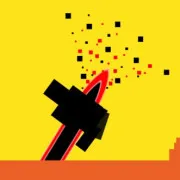Keep the pixel T-Rex running forever
Keep exploring
Keep the momentum going with more arena racers, action trials, and puzzle standouts.

Play Happy Land instantly in your browser

Turn dominoes into a daily deduction ritual

Catapult, flip, and nail the landing

Assemble Chiikawa’s Crew from Memory

Slip into Hallownest and start exploring now

Play Level Devil 3 in Your Browser

Break in fast, cash out faster

Wheelie Life – Master the One-Wheel Stunt

Play Water Color Sort in Your Browser

Play Slope Rider Online
Master the minimalist runner
Run farther with simple, precise inputs
The Dino Game distills endless running to a crisp rhythm of jump, land, and recover. A tiny T-Rex bolts across a flat desert while hazards approach at a steadily increasing clip. Cacti arrive in single stems and stacked clusters; pterodactyls swoop at alternating heights; the sky cycles from day to night and back again as your score climbs. With no power-ups, coin shops, or complicated UI, the Dino Game puts all emphasis on timing, consistency, and a calm mindset. Each run is a compact lesson in reading patterns and reacting cleanly. Miss once and you’re done—but instant restart means a fresh attempt is always one tap away.
Why this tiny runner hooks players
The Dino Game earns loyalty through clarity. You always know exactly why you failed and what to try next. The speed increase is gradual and fair, telegraphing a reliable rhythm that rewards practice. Crunchy jump sounds, minimal animation, and the stark desert palette keep your focus on spacing—where your arc will crest, how quickly your feet replant, and whether you have time to duck. In the Dino Game, discipline beats luck; micro-adjustments accumulate into new personal bests.
Unlike many arcade titles, the Dino Game wastes no time with menus. You hit jump, you run; you collide, you reset. That frictionless loop makes it perfect for short sessions during breaks or long practice windows where you refine technique. The day-night shift adds subtle variation without obscuring hazards, and the scoring ticks forward with every length of ground you cover. In the Dino Game, momentum is psychological as much as mechanical—when your nerves steady, your score soars.
Controls, readability, and movement arcs
Core inputs in the Dino Game are intentionally sparse: space, W, or the up arrow to jump; down arrow to duck when available. The jump has a responsive start, a predictable hang, and a snappy landing, letting you chart arcs against cactus heights. Short taps clear low singles; full presses handle tall stacks. The Dino Game teaches you to modulate jump length so you don’t land too near the next obstacle. Over-jumping is a common early mistake; with practice, you’ll float just enough to pass the hazard and touch down with recovery frames intact.
Readability is excellent. Cacti silhouettes are chunky and distinct; avian threats change altitude in visibly different bands. The Dino Game wants you to succeed by seeing early and reacting on beat. As speed climbs, your window narrows, but the same fundamentals carry you forward—clean eyes, measured inputs, and a steady tempo. If you feel chaos rising, that’s the cue to reset your breathing and re-center on the runner’s footfalls.
Scoring and difficulty ramp
Scoring in the Dino Game is linear with distance, turning each run into a distance-per-life challenge. Every few hundred points, the pace tightens, exposing sloppy arcs and late jumps. That ramp is the heart of the Dino Game: by nudging you just outside your comfort zone, it forces better spacing and a more economical jump button. Push past each speed threshold and your hands adapt, until yesterday’s panic feels like a warm-up.
Practice framework for steady improvement
Approach the Dino Game like a musician practicing scales. Warm up with ten quick runs that focus only on smooth landings; don’t chase score yet. Next, spend five runs practicing micro-jumps over single cacti, aiming for the smallest possible arc that still clears. Then add in mixed cactus stacks, rehearsing double-hazard spacing. In the final block, bring in pterodactyls; rehearse duck timing so the head stays low only as long as needed. By batching skills, the Dino Game stops feeling random and starts to map into rehearsed patterns you can execute under pressure.
Break plateaus by reviewing where runs die. If you routinely clip tall stacks, you’re probably launching too late; move your jump cue a few pixels earlier. If pterodactyls catch you mid-air, commit to a lower, shorter hop or hold your ground and duck. In the Dino Game, small corrections compound. Adjust one habit at a time across five to ten attempts; then reassess your consistency before tackling the next weakness.
Advanced techniques for higher ceilings
At speed, rhythm outruns raw reaction time. The best Dino Game players pre-buffer inputs on the beat of the runner’s stride. They visualize the jump arc as a bubble that must intersect hazard height at just the right moment; their hands act on that visualization rather than on panic. Practically, this looks like feathering the jump key for precise elevation and landing early enough to have full control before the next obstacle. For bird patterns, memorize the typical low and mid flight bands; when in doubt, duck first, then hop the following cactus with a tight arc. The Dino Game rewards this composure with streaks that carry you past former caps.
Another tip: treat multi-cactus clusters as a single shape. In the Dino Game, one jump can clear two low cacti if you launch early with a longer press. Conversely, when clusters mix heights, split them into two quick hops—one short, one tall—so you land reset-ready between stems. Practicing both approaches gives you flexibility when pattern mixes appear late in a run.
Mindset, ergonomics, and session length
The Dino Game is deceptively meditative. Runs crumble when tension spikes; they thrive when you relax. Keep shoulders down, wrists neutral, and breaths even. If frustration creeps in, take a 60-second pause—your jump timing will return fresher. Short sessions of 10–15 minutes often produce better breakthroughs than marathons. Because the Dino Game restarts instantly, it’s easy to over-grind; use small, focused blocks to cement improvements without fatigue.
Accessibility and minimal system demands
Part of the charm is how broadly the Dino Game runs. Keyboard controls are simple, visuals are high-contrast, and the browser footprint is tiny. That reach makes the Dino Game a go-to recommendation for quick fun on shared machines, school laptops, or travel rigs. With nothing to install and no save data to manage, it’s always ready when you are.
Why players keep coming back
Mastery loops drive replay. In the Dino Game, you can feel yourself improve within a single sitting: arcs get tighter, ducks get shorter, and your landing cadence stabilizes. The day-night shift marks progress milestones, turning the background into a quiet scoreboard. Even failures motivate; each collision is a specific note—“jump earlier,” “shorter arc,” “duck sooner.” String those notes into habits and the Dino Game delivers steady, satisfying growth.
Ultimately, the Dino Game is the rare title that respects your time. It asks for attention, offers immediate feedback, and never dilutes the core with clutter. Whether you’re chasing a quick dopamine hit or a long-term high score, the Dino Game meets you at your level and pushes you one clean jump beyond.
Keep the pixel T-Rex running forever is ready to play
Sprint past cacti and birds in the classic Dino Game. Jump and duck with simple keys, chase endless high scores, enjoy instant restarts, and master the desert rhythm.
Share Keep the pixel T-Rex running forever
Spread the word, invite friends, or bookmark this page to revisit the story whenever you need it.